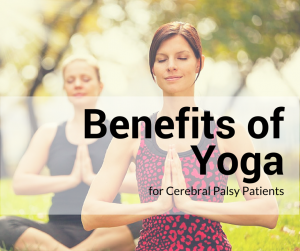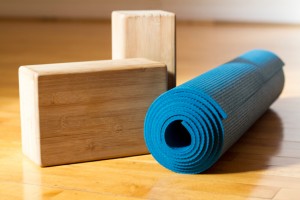 Due to its skyrocketing popularity over the last decade, everyone has heard of yoga. We know it involves bending and contorting one’s body, and that there are special pants and a mat that people carry. But what is it really?
Due to its skyrocketing popularity over the last decade, everyone has heard of yoga. We know it involves bending and contorting one’s body, and that there are special pants and a mat that people carry. But what is it really?
Yoga is defined as a spiritual and ascetic discipline derived from Hinduism that includes breath control, meditation and a series of physical poses, widely practiced for health and relaxation.
We often think of exercise as a way to build our muscles — to make us stronger. This is true, but for many people with cerebral palsy, their body craves just the opposite. Their muscles, which are often tensed beyond their control, crave relaxation. For many people with cerebral palsy, practicing yoga has become a part of their lives that brings them mental and physical happiness.
Muscle Tone Therapy
One of the tangible benefits to someone with cerebral palsy practicing yoga is the ability to significantly reduce high muscle tone. This is especially the case with children who suffer from cerebral palsy. High muscle tone is when there is too much tension in muscles while at rest. So even when the muscle isn’t being used, it is tight and tense. This is known as “high muscle tone,” and it appears in patients with spastic cerebral palsy, causing their arms and legs to be contorted and resistant to movement. Stretching and physical therapy can help with this condition, but more and more people are seeing the benefits that yoga can have on easing high muscle tone.
Practicing yoga and the accompanying relaxation has been shown to help people with cerebral palsy. Holding an asana (a yoga pose) helps the muscles and tendons to gently stretch and achieve a relaxation that releases the general stress experienced by the body, thus relieving the tightness throughout the muscles.
While the yoga poses help to relax certain muscle groups that are contracted more than is considered normal, other muscle groups that are weaker than they should be can be strengthened. This is the part of yoga that can be revolutionary to a person who suffers from cerebral palsy. Both high and low muscle tone issues can be helped at the same time.
One of the most significant benefits to children is the way asanas straighten and realign the spine. Movements associated with asanas bend and stretch the spine, creating more space between the vertebrae and reducing pressure on the spine’s disks and nerves. This stretching releases muscle tension and even enhances overall nerve function, as well as range of motion.
Adaptive Yoga
There are yoga classes specifically designed for people with disabilities. Watching yoga on TV or the Internet might seem overwhelming at first. Some of the poses often look impossible for an able-bodied individual, let alone someone with a limited range of motion. This shouldn’t be discouraging. Adaptive classes modify the asanas for any level of ability, including beginners or those with range of motion limitations. If needed, the instructors can actively assist the patient, and poses can even be done from a chair or wheelchair. Many people find it helpful to start out in a one-on-one class and then progress to group lessons.
 Adaptive yoga reimagines the traditional yoga practice by incorporating various props – chairs, walls, therapy tables, pillows, blankets, yoga blocks, yoga straps, mats and sandbags – so that people with varying degrees of ability can hold a variation of an asana with an appropriate level of effort.
Adaptive yoga reimagines the traditional yoga practice by incorporating various props – chairs, walls, therapy tables, pillows, blankets, yoga blocks, yoga straps, mats and sandbags – so that people with varying degrees of ability can hold a variation of an asana with an appropriate level of effort.
The inclusive nature of practicing yoga is something that can be very comforting to a beginner. Adaptive yoga teachers and therapists work diligently to help anyone learn asanas. There are movements and poses designed for any level of physical ability. The progress that adaptive yogis see after even a few weeks of practice encourages them to stick with it as they get stronger and more advanced.
Besides the obvious increase in muscle tone and flexibility, there are numerous other health benefits. Yoga has been shown to benefit the digestive system as well as the cardiovascular system. Certain types of yoga can increase heart rate enough to be an aerobic exercise. The practice of pranayama yoga (a variety that emphasizes the importance of deep breathing) helps to expand lung capacity and strengthen the heart. An individual’s immune system can be strengthened as the physical activity and stretching can develop strong muscles that continually encourage lymph movement.
‘Chair Yoga is Awesome.’ – Ryan McGraw
One need look no further than Ryan McGraw to see how beneficial yoga can be for someone with cerebral palsy. McGraw, who grew up with cerebral palsy in the suburbs of Detroit, reluctantly tried yoga at the behest of his mother. After practicing yoga for a decade, he now sings its praises as an activity that has made a huge difference in his emotional and physical wellbeing. He practiced yoga throughout college and says:
“The adaptations take yoga to whole new level – it’s amazing how you can adapt a pose to fit your body with the use of props.”
Regardless of one’s physical limitations, it is best to stay as physically fit as possible. While people with cerebral palsy might not be able to go for runs or long bike rides, yoga is something that just about anyone can do as a means of staying fit.
“It improves strength, coordination and flexibility,” he says. “Those are the physical issues a person with cerebral palsy has to address.”
How to Get Started
If you are new to yoga, it is always best to learn the practice from a certified professional teacher. The International Association of Yoga Therapists and Yoga for the Special Child are two great resources that can help get you on the right track when it comes to finding listings of yoga therapists.
No matter who you are, yoga seems to be beneficial to both the mind and the body. With the practice of yoga growing rapidly throughout the country, people with cerebral palsy are now offered more and more opportunities to help their muscles learn to relax as well as become more self-reliant through a centuries-old practice that has been shown to have proven results.



